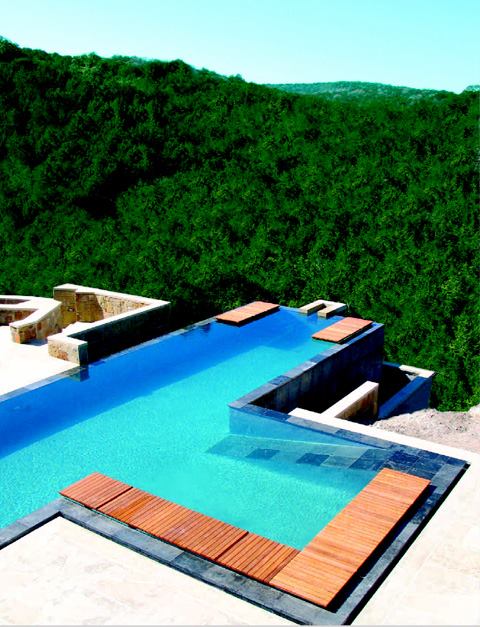To accomplish this, every crew member must work as close to the plans as possible. Only the most exact excavation, steel, and shotcrete application will enable the masons who set the edge tile or stone to achieve perfection. If using tile, setters must be sure to make it flush with the grout joints. Some like to use stone because high spots can be ground down. When using a rougher variety, however, you’ll need to feed more water to wet the edge.
The Sounds. One characteristic of perimeter-overflow pools is the possibility for a noise hazard. This happens because water moves through plumbing via gravity from the gutter to the holding tank. There’s no pump to create a vacuum, so air exists in the lines. As water drops into the pipe, that air is displaced and needs a place to go. If not handled properly, the pool can make the same gurgling sound as a 5-gallon water bottle when it’s propped up on a dispenser.
Pool builders solve this problem using several methods. Gravity-feed lines must always be larger than those utilized in a pressurized system. The standard 2- to 3-inch lines would become full, and water would force the air up and out. Instead, size the pipes so they are only one-third full of water at any given time. You will probably need 4-, 6-, or even 8-inch plumbing. These lines should not run vertically downward. Rather, install them at a ¼-inch-per-foot slant. This way, water can amble slowly.
On top of that, it’s a good idea to include some type of noise-elimination device. Many builders place air vents in the pipe leading from gutter to tank. You can also oversize the gutters, so the water has plenty of room to move. Another option is to place drains on the walls of the gutters instead of the floors, so that water exits horizontally.
The Storage. Builders can create the tank themselves from concrete or install a prefabricated unit suitable for holding potable water. While some like the ease of a manufactured product, others feel more confident in their own construction
Either way, the tank must sit below the gutters so that water can gravity-feed downward to it. The container must be large enough to hold all the water that’s not directly in the pool. This includes rain and water in transit (that which is moving through the plumbing when the overflow pump is running). Once the system shuts off, the pipes and gutters will drain everything to the tank, unless the plumbing is used for storage.
Outfit the tank with both automatic-fill and overflow devices to maintain the right amount of water in the system.
The Cleaning. Perimeter-overflow pools have unique maintenance concerns. The pool builder should design the vessel to facilitate cleaning as much as possible. Because of their high water level, these pools have no skimmers to help sift out leaves and other debris. Dirt will head straight for the edges and hit the slot or grate. While some pool builders prefer to design a system for minimal flow, you can also feed a little more water over the top, so that its force helps direct matter over into the gutter, says William Palmer, president of Las Vegas-based Prestige Pools.
The choice of slot or grate can affect the ability to clean the pool. Grates are generally easier to remove and have more open area in which dirt and particles can fall, says Lew Akins, president of Ocean Quest Pools by Lew Akins in Belton, Texas.
But some like the look of a slot better. You can size this space on the larger side to help debris fall through. Sargent creates a 1-inch gap between the edge of the slot and the deck. This not only allows more debris to fall through, but it also accommodates a small nozzle so a service tech can spray down the gutters. Some don’t like the way this looks, however, and prefer narrower openings. You can also install some of the coping stones immediately surrounding the slot so they can be removed for access.



